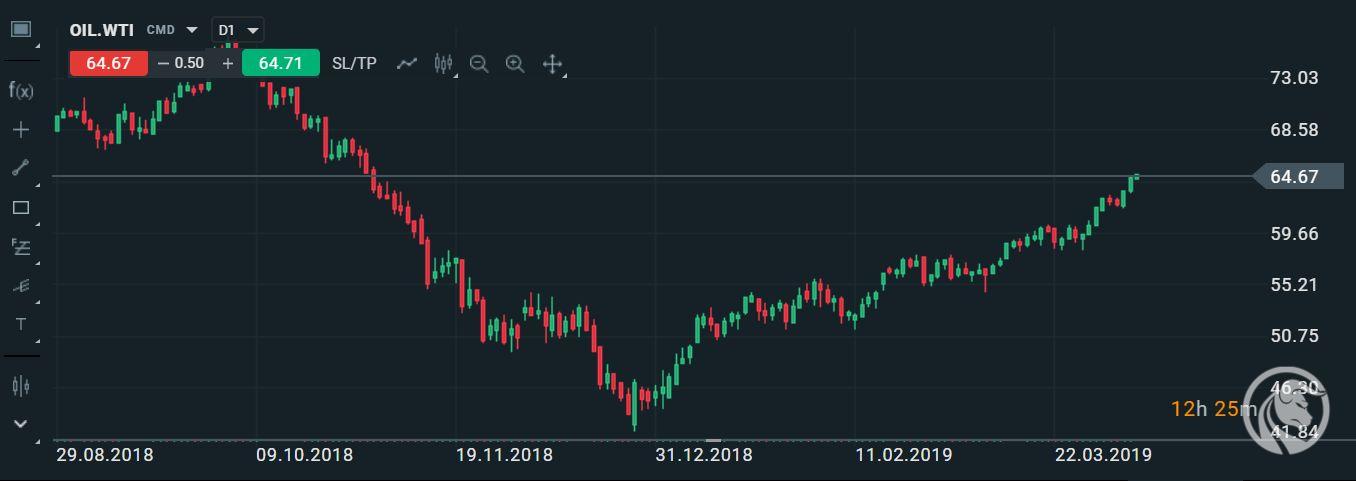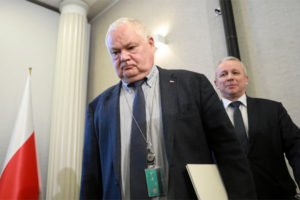The oil price is growing on the wave of conflicts
Riots in Libya, protests in Algeria and Sudan, confusion around the OPEC cartel and information from Norway, which questions the legitimacy of further investment in mining "Black gold" - these are the main causes of the latter increases in oil prices. The rate is growing, and Goldman Sachs is still raising the price forecast.
Last week ended with the highest increases in oil prices for two months. Nearly 5 percent increase in price to Friday, and from Monday we observe the continuation of the course heading north. There is no shortage of reasons for such quick changes in prices.
Check it out: Brokers Offering Crude Oil Trading - Fact Sheet
War always "helps" oil
The first is, of course, the civil war in Libya. Any armed conflict in a country that produces oil, or even is transported through it, causes an increase in oil prices on world markets. It is no different this time. The situation is already so tense that the Libyan government is about to launch a massive counterattack should its capital, Tripoli, be attacked.
Libya is currently producing on the largest oil field in the country 293 thousand. oil barrels a day. Despite the increase in tension in the region, production continues, but analysts are afraid that it may be stopped at any moment.
Ahn yea Ha, market analyst at Kiwoom Securities Co. .:
"The possible disruptions in Libya's oil production are driving the price of the commodity up at a time when the markets' appetite for risky assets is growing as concerns about global economic growth have ebbed."
The 23 people have already been killed in the clashes in Libya, but the conflict is constantly inflaming. It is possible, then, that the black scenario will come true.
Norway no longer pays for oil?
Surprising information also comes from Norway - a country that has built its economic power over the years thanks to oil and gas. The Scandinavian tiger limits its interest in further investments in this industry more and more.
The Labor Party has decided to withdraw from supporting oil exploration along the Lofoten coast in Arctic Norway. As a result, there is already a majority in parliament that does not want to search for oil in this area. In fact, look for specific deposits, because everything indicates that oil is there, and it is quite a lot - it is estimated that there is about 3 billion in this area. barrels.
The oil industry is this information broken down. The largest Norwegian energy company Equinor ASA (formerly Statoil) in the statement emphasizes that access to the Lofoten Islands is crucial if Norway still wants to maintain oil production levels. First of all, because currently exploited deposits are slowly depleting.
- The entire industry is surprised and disappointed. It does not help to maintain the stability that has always been our foundation - says Karl Eirik Schjott-Pedersen, head of the Norwegian Oil and Gas Association.
Norway's largest refining union, Industry Energy, also criticizes this decision.
- This creates instability in the policy discussion for an industry that depends so heavily on the long term perspective. We cannot agree to this Thunders Frode Alfheim, head of the union.
Goldman Sachs raises the forecasts
As a result of these turbulences, the oil price is rising, and analysts predict that this is not the end. The Reuters agency has just announced that Goldman Sachs expects the average Brent crude oil price this year to be USD 66. Previously, he estimated it at 62,50 USD. The bank also increased the forecast of the average WTI oil exchange rate from 55,50 USD from 59,50 USD.
Brent crude from June contracts is currently listed after 71,14 USD, and WTI crude from May contracts after 64,54 USD.
The reason for the increase in the valuation is, inter alia, the reduction of oil exports by the OPEC cartel and the sanctions imposed on the supply of oil from Iran and Venezuela. The further development of the armed conflict in Libya may also play a significant role.
Crude oil ends (?)
The rise in oil prices is directly influenced by the imbalance in demand and supply. Goldman Sachs analysts estimate that in the second quarter oil shortages will be around 0,5 million barrels per day. They also expect Brent oil prices to be characterized by the so-called "Backwardation", which means that longer delivery contracts will be cheaper than deliveries at the present time. This is a sign that the market is getting tighter.
Goldman Sachs raised its Brent oil price forecast for the second quarter of this year from 65 USD to 72,50 USD. maintained while the Brent oil price forecast next year at 60 USD.






















![Forex Club – Tax 9 – Settle tax on a foreign broker [Download the Application] Forex Club - Tax 9](https://forexclub.pl/wp-content/uploads/2024/02/Forex-Club-Podatek-9-184x120.jpg?v=1709046278)
![Trading View platform – solutions tailored to the needs of traders [Review] trading view review](https://forexclub.pl/wp-content/uploads/2024/03/trading-view-recenzja-184x120.jpg?v=1709558918)
![How to connect your FP Markets account to the Trading View platform [Guide] fp markets trading view](https://forexclub.pl/wp-content/uploads/2024/02/fp-markets-trading-view-184x120.jpg?v=1708677291)
![CRB index – one of the popular commodity market benchmarks [Guide] crb index](https://forexclub.pl/wp-content/uploads/2024/05/indeks-crb-184x120.jpg?v=1715055656)
![How to invest in ChatGPT and AI? Stocks and ETFs [Guide] how to invest in chatgpt and artificial intelligence](https://forexclub.pl/wp-content/uploads/2023/02/jak-inwestowac-w-chatgpt-i-sztuczna-inteligencje-184x120.jpg?v=1676364263)





![Izabela Górecka – “Success on the market depends not only on knowledge, but also on emotional stability” [Interview] Izabela Górecka - interview](https://forexclub.pl/wp-content/uploads/2024/04/Izabela-Gorecka-wywiad-184x120.jpg?v=1713870578)
![WeWork – the anatomy of the collapse of a company valued at $47 billion [WeWork, part II] wework bankruptcy story](https://forexclub.pl/wp-content/uploads/2024/04/wework-bankructwo-historia-184x120.jpg?v=1711729561)
![Adam Neumann – the man who screwed up Softbank [WeWork, part AND] adam neumann wework](https://forexclub.pl/wp-content/uploads/2024/04/adam-neumann-wework-184x120.jpg?v=1711728724)


![The most common mistakes of a beginner trader - Mr Yogi [VIDEO] Scalping - The most common mistakes of a beginner trader - VIDEO](https://forexclub.pl/wp-content/uploads/2024/03/Scalping-Najczestsze-bledy-poczatkujacego-tradera-VIDEO-184x120.jpg?v=1711601376)
![Learning patience: No position is also a position - Mr Yogi [VIDEO] Scalping - Learning patience - No position is also a position - VIDEO](https://forexclub.pl/wp-content/uploads/2024/03/Scalping-Nauka-cierpliwosci-Brak-pozycji-to-tez-pozycja-VIDEO-184x120.jpg?v=1710999249)
![When to exit a position and how to minimize losses - Mr Yogi [VIDEO] Scalping - When to exit a position and how to minimize losses - VIDEO](https://forexclub.pl/wp-content/uploads/2024/03/Scalping-Kiedy-wyjsc-z-pozycji-i-jak-minimalizowac-straty-VIDEO-184x120.jpg?v=1710336731)




















Leave a Response